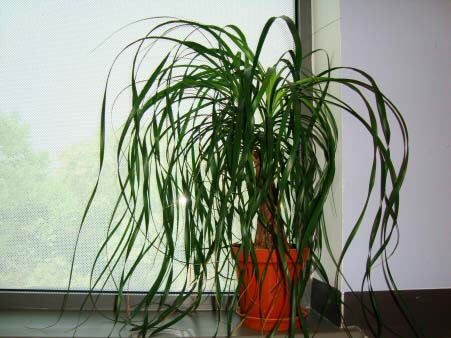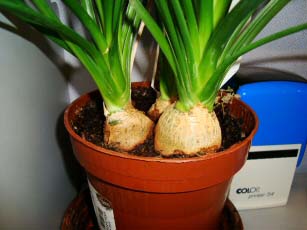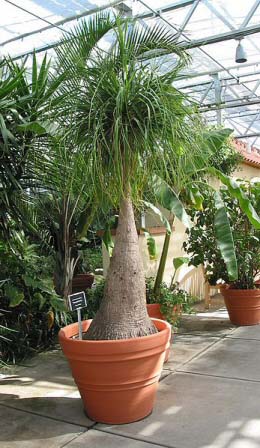





Beaucarnea, or Nolina as it's sometimes called, is often known as the Ponytail Palm or Elephant's foot. Dr Hessayon describes it as "A curiosity rather than a thing of beauty"  however we are more inclined to say it's both. The Ponytail Palm is a distinctive looking houseplant with a swollen thick brown stem at its base that stores water. The long narrow curly, dark green leaves flow up from this base much like a plume of water in a fountain. Years later the plant becomes significantly taller and has an appearance which in our opinion better resembles a miniature Willow tree. Elegant, curious and beautiful.
however we are more inclined to say it's both. The Ponytail Palm is a distinctive looking houseplant with a swollen thick brown stem at its base that stores water. The long narrow curly, dark green leaves flow up from this base much like a plume of water in a fountain. Years later the plant becomes significantly taller and has an appearance which in our opinion better resembles a miniature Willow tree. Elegant, curious and beautiful.
It hails natively from the dry regions of Mexico, and the ability to hold water in the trunk is clearly an adaptation of coming from such an arid place. Although able to survive with little water and care, it does best if watered frequently and as the plant is very slow growing anyway it's a good idea not to treat it poorly if you can help it.
When  you come to buy Beaucarnea it's common to find either a pot with one mature plant, or a smaller pot with a cluster of typically three small plants in it. The smaller pot is a quick fix if you want an instant flush of leaves without having to wait several years for them to actually grow. Although the mature Ponytail Palm has that stand out quality, as always when it comes to house plants, those which take a long time to grow are typically more expensive. In any case which ever style you end up choosing as long as you treat it well the Ponytail Palm will be with you for many, many years.
you come to buy Beaucarnea it's common to find either a pot with one mature plant, or a smaller pot with a cluster of typically three small plants in it. The smaller pot is a quick fix if you want an instant flush of leaves without having to wait several years for them to actually grow. Although the mature Ponytail Palm has that stand out quality, as always when it comes to house plants, those which take a long time to grow are typically more expensive. In any case which ever style you end up choosing as long as you treat it well the Ponytail Palm will be with you for many, many years.
Light
Beaucarnea grows slowly at the best of times and although the plant will do OK in a slightly shady spot, it does need bright light for success. If you can provide some sun you will see the plant converting this into lush new visible leaves, i.e. more light equals more growth.
Watering
At the base of the Ponytail Palm is a very thick swollen stem that has a woody appearance. This is actually a water storage organ, which is capable of supporting the plant in times of drought. You should aim to water at least a few times a month (once a week in the height of Summer if possible) and when you do so, make sure it's a thorough watering. The water reserves will support the plant if you forget to water it from time to time, but don't make this into a habit or you will get a surviving rather than thriving plant.
Humidity
The leaf edges and tips of your plant will brown if the humidity is very low, but otherwise humidity isn't overly important.
Feeding
A light feed once every few weeks in Spring and Summer. A general fertiliser will be fine.
Temperature
When it comes to temperature requirements unlike most house plants the Ponytail Palm is close to being hardy and will accept almost sub zero temperatures. Exposing your plant to such a low temperature however would surely be by accident and not a regular occurrence right? *wink*. Aim for no lower than 7°C / 45°F and although higher temperatures will be accepted, try to achieve 21°C / 70°F to provide good growing conditions.
Repotting
If growing well you could be repotting once a year. If conditions are not so good or you want to restrict the size of the plant, only repot every 2 or 3 years. No special soil or tips need to be followed when you do change the pot other than form an appearance and cosmetic point of view you might want to try and go for a tall container to help keep the long leaves from dragging along the ground.
Propagation
Propagating a Ponytail Palm is pretty difficult because it's done typically through the offsets it periodically produces. The difficultly is that the offsets depend on the parent plant and don't establish their own roots very quickly. This means if you separate an offset too early then it will rely on you to get things spot on. None of the Our House Plants.com team have propagated a Ponytail Palm, but if you give it a try you might like to use a rooting hormone to increase your chances. Conditions should then be provided as  above.
above.
Speed of Growth
Very slow or non existent growth if light levels are poor or you never water the plant. Otherwise expect slow growth.
Height / Spread
Most Ponytail Palms in the home will never reach this height, but out in their natural habitats they can almost touch the sky at a whopping 15 feet / 4.5 meters.
Flowers
Yes this house plant does have flowers! But very rarely indoors and even if you do get them, they are unremarkable.
Anything else?
Because the Ponytail Palm is so well adapted to storing water, you may find it listed as either a succulent or a foliage plant. In addition in temperate regions it may be sold as a garden rather than indoor plant. Only buy plants called Beaucarnea, or Nolina "Recurvata".
Copyright © www.100flowers.win Botanic Garden All Rights Reserved